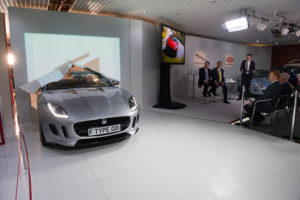A sporting Future – Jaguar C-X16 Concept
Reproduced with permission of Jaguar World Monthly Magazine (November 2011)
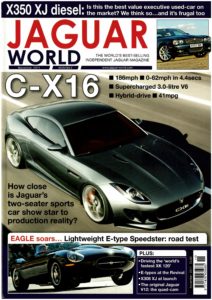
Jaguar World
November 2011
All-aluminium construction, electrifying performance, stunning contemporary styling and strictly two seats – the C-X16 concept has all the ingredients to put Jaguar back on the map as a sports car manufacturer. So how close is it to reality?
As you read this, the 2011 Frankfurt motorshow will have ended following two weeks of frenetic activity – and the world’s motor manufacturers will have returned to their respective bases hoping that their latest concepts, new models and future plans made a significant impact on both the international press, and the buying public… In Jaguar’s case, its C-X16 concept certainly accomplished the former – one need only look at the headlines in the automotive press to recognise that – but the effect it had on potential buyers is impossible to measure, for the clear reason that no orders were being taken!
Yet all indications are that the ‘real’ new Jaguar small sports car which the C-X16 previews will debut next year, and that begs the inevitable question, how close will it be to the concept?
The simple answer, as we predicted last month, is that it’s likely to be very similar indeed. An open version is also in development of course, and whether that will go on sale before the coupe or they will debut together is yet to be determined, but more than with any other concept from Jaguar in recent times, a close analysis of the C-X16 is worthy from a likely production perspective. So, how does it stack up?
Overview
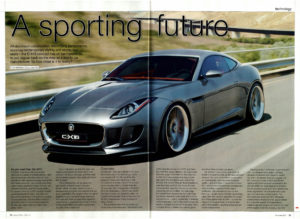
Jaguar World – November 2011
A sporting future
CX16 Pages 24-25
For starters – let’s get a handle on its size, the easiest way to do that being a quick comparison with the XK, currently the marque’s most overtly sporting model. At 4,445 mm in length, the C-X16 is a not inconsiderable 349 mm shorter than the XK (and just 10 mm longer than a Porsche 911); its wheelbase is 130 mm less, and it sits 25 mm lower. It is, however, wide – at 2,048 mm it’s actually 20 mm wider than the XK (this measurement being inclusive of wing mirrors).
The aluminium skin that fills those low, squat proportions features a ‘trapezoidal grille’ of the type first shown on C-X75, and three key lines that design director, Ian Callum (see interview, page 30) is keen to draw attention to: the front wing creases that begin in the gills below the headlights each side of the bonnet, then extend through those headlights, over the wings and into the doors; the rear haunches that wrap into the low tail, and the sweeping and low roofline. You can judge for yourself from the pictures how well these key design elements work within the C-X16’s complete form – which, incidentally, is finished in Gunmetal grey – but to this writer’s eyes the result in the flesh is a car full of sporting intent. In simple terms, it makes you want to get in and drive it the moment you see it…
As for how it could drive, and while no details of suspension set-up etc have yet been released, the car’s all aluminium construction will undoubtedly mean excellent torsional rigidity – just as it does in the current XJ and XK – which in turn should mean exceptionally crisp handling. A quoted 50:50 weight distribution will undoubtedly help on that front too – weight being 1,600 kg, some 60 kg lighter than the naturally -aspirated XK coupe and 153 kg lighter than an XKR – so with the classic front engined/rear drive layout also part of the equation, sporting drivers should not be disappointed.
The engine too – a V6 petrol supercharged unit – promises to be a peach, not least because it’s derived from Jaguar’s current V8, which we already know is a superb unit. With bore and stroke at 84.5 and 89 mm respectively (both reduced compared to the V8’s 92.5 mm x 93 mm), total capacity is 2,995 cc, the V6 using the same aluminium architecture as its ‘big brother’ V8 complete with quad-cam four-valve per cylinder heads. The V6 should also share the V8’s refinement characteristics thanks to what Jaguar states is a ‘patented system of independently rotating balancer weights at the front and rear of the engine’. In terms of output, the V6’s figures make for impressive reading. With a revised direct injection combustion system, a compression ratio of 10.5:1 (the supercharged V8s running at 9.5:1), and a new electronic bypass for the Roots supercharger, the V6 is not only optimised for fuel efficiency, but its peak output of 380 bhp equates to a capacity specific figure of 126 bhp per litre – better than the supercharged V8’s 110 bhp per litre in XKR-S tune. With peak torque also at 332 lbft, it promises to be compelling stuff – but the ‘motive’ story doesn’t end there.
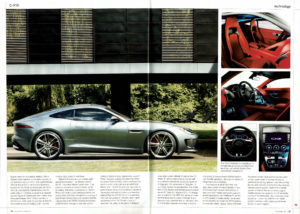
Jaguar World – November 2011
A sporting future
CX16 Pages 26-27
Mated to the engine is ZF’s latest eight-speed transmission – as already used in the XF – but here fitted in hybrid form. That means it contains an electric motor within its casing, this being powered by a 1.6 kWh lithium-ion battery pack (situated behind the seats) which is in turn charged by a Formula 1 type Kinetic Energy Recovery System (KERS). Jaguar state’s the KERS charges the battery predominately through a ‘rear axle electro-hydraulic brake energy regeneration system’. When charged, a press of a steering wheel-mounted ‘Push to Pass’ button activates the electric motor which delivers an additional 95 bhp and 173 lbft for up to ten seconds. In performance terms, the combined outputs of the engine and electric motor give headline-claimed figures of 0-62 mph in 4.4 seconds, a limited top speed of 186 mph in just 2.1 seconds, and in gear acceleration from 50-75 mph in just 2.1 seconds. Yet, allied to the same ‘intelligent’ stop-start system already in use on the 2.2 diesel XF, all this performance comes with a combined claimed fuel economy figure of 41 mpg and CO2 emissions of 165 g/km. To put those figures into perspective, they make the C-X16 cleaner and almost as economical as an XF Diesel S (169 g/km CO2 / 44.8 mpg), and a match for the XKR-S in terms of those performance benchmarks (0-62 mph) in 4.4 seconds, top speed limited to 186 mph). The C-X16 is also capable of running in electric only mode at speeds below 50 mph and on light throttle openings, although no details of range have been released.
How feasible is all of this? Well, the stop-start system is clearly already in use, ZF’s hybrid eight-speed transmission is also production ready, and given Jaguar’s recent association with Williams F1 on the C-X75 project, it undoubtedly has access to the expertise to make the KERS system an everyday reality. Jaguar states that both the electric motor itself and the battery pack will be liquid cooled to ensure no loss of performance during ‘spirited’ use, the cooling for the latter actually coming from the vehicle’s climate-control system. Given that a hybrid system is likely to feature on future Jaguar models across the range by dint of necessity, putting it into production first in the new small sports car – which by definition will mean smaller volumes – also makes good sense. Expect to see it happen.
Stepping inside
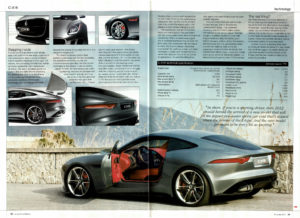
Jaguar World – November 2011
A sporting future
CX16 Pages 28-29
A touch on the flush driver’s door handle sees it arc out from its rear edge, a gentle pull then releasing the door to reveal an interior that immediately impresses in two ways. For starters, the contrasting Vermilion red leather and black suedecloth main theme looks stunning – the use of anodised aluminium, carbon-fibre and dark chrome enhancing the sporting feel – but more significantly, nothing looks beyond the realms of production possibility. There’s new technology yes, but nowhere are there features that appear to be solely the whim of a designer’s imagination.
The deeply sculptured carbon-fibre backed bucket seats are manually adjustable, the speedometer and rev counter are conventional analogue dials, and the column switchgear is that already in use on existing Jaguar models. All these aspects are worth highlighting, because on concepts that never need to actually work they are some of the first items that designers may get a little carried away with… There’s also no rotary gear selector – the stubby lever rising from the carbon-fibre clad centre console bearing the P-R-N-D pattern on one side, and the symbols – ‘S’ on the other., the latter indication it could be used for sequential shifts in addition to the steering-wheel mounted paddles. Ahead of that lever sits the stop/start button, and above it a row of toggle switches controlling various functions such as hazards, air-con recirculation etc. Above these are three simple rotary dials that feature OLED displays and which promise to be clever pieces of kit as they are dual function.
Rotating them controls cabin temperature on both sides of the car, the setting being displayed in their centres, but by pushing them they control the heated seats – the displays at their centres changing to suit.
The touchscreen that sits above these rotary switches is also a ‘next generation’ unit that incorporates some clever smartphone connectivity. With a smartphone plugged into a machined aluminium tray between the front seats, the touchscreen will reconfigure to mimic the phone’s display. Above that touchscreen the dash top is flush, but when necessary a double vent will rise from it to deliver the maximum flow of hot or cold air as appropriate, the vent then falling from view again once cabin temperature has been suitably regulated.
And everywhere there are neat touches to catch the eye, without the resort to overexuberant design. The suedecloth headlining features a hand-quilted pattern that represents the famous Jaguar ‘lozenge’ badge, a machined aluminium cover with integral heatsinks hides the battery pack behind the seats, while a carbon-fibre bracing bar flows back from the seat-dividing centre console then splits to mate to the rear suspension turrets to further aid rigidity. The overall interior effect is fresh, classy and overtly sporting but, above all, absolutely realistic – a feeling that sums up the entire C-X16 concept.
The real thing?
Yes, there are sure to be some elements of the car that may not make it to production – the centre-lock 21 in alloy/carbon fibre wheels for example – but in the vast majority of the design there is nothing that seems too far fetched and, as Ian Callum himself tells us, the C-X16 meets all legislative requirements as it stands. It even has perfectly standard looking windscreen wipers for goodness sake!
In short, if you’re a sporting driver, then 2012 should herald the arrival of a new model that will fill the Jaguar two-seater sports car void that’s existed since the demise of the E-type. And the new model promises to be every bit as exciting.
| C-X16 technical specification | |
| Estimated figures ** PS | |
| Engine type: | V6 petrol, four-valves per cylinder, direct injection, supercharged |
| 0-62 mph (secs): | 4.4 |
| Capacity (cc): | 2,995 |
| Top speed (mph): | 186 |
| Bore/stroke (mm): | 84.5 x 89 |
| 50-75 mph (secs): | 2.1 |
| Max power (bhp**): | 380 |
| Combined mpg: | 41 |
| Max torque (lb ft): | 332 |
| Combined CO2 (g/km): | 165 |
| Transmission: | Eight-speed with integrated electric motor |
| Hybrid system voltage: | 300 |
| Lithium-ion battery: | 300 V / 1.6 kWh |
| Power (bhp**): | 95 |
| Length (mm): | 4,445 |
| Wheelbase (mm): | 2,622 |
| Width (mm): | 2,048 |
| Height (mm): | 1,297 |
| Torque (lb ft): | 173 |
| Weight (kg): | 1,600 |
Postscript: Production F-TYPE
Although the C-X16, with petrol-electric hybrid drive, never made it into production, the body style and shape did, with very few changes, in the form of the Jaguar F-TYPE which was launched in both coupe and convertible versions. The first production F-type, is now in the care of the Jaguar Daimler Heritage Trust, on display in Coventry Transport Museum. This is a convertible, chassis number 001, and left the production line in Castle Bromwich on 4th March 2013.
Ian Callum on the C-X16
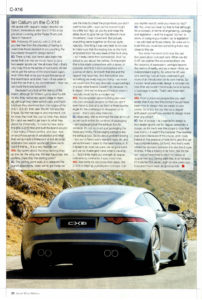
Jaguar World
November 2011
Ian Callum on the C-X16
CX16 Pages 28-29
We [Jaguar World] spoke with Jaguar’s design director, Ian Callum, immediately after the C-X16’s initial pre-show unveiling at the Palais Thurn und Taxis in Frankfurt.
MS: Following XF and XJ, with C-X16 did you feel free from the shackles of having to overcome those resistant to you pushing the boundaries forward in design terms?
IC: There is that, but there’s also been this sense that one day we would have to do a two-seater sports car. We all knew that – that’s why I say this is the sense of our brand. At last we’ve got the sense of the brand back again. And I think that once you’ve got the sense of the brand back and solid, then – if we were to build this car that is, no commitment! – then we can build the brand around it,
Because if you look back at the history of the brand, although Sir William Lyons liked his Mk Xs etc, they had a sporty edge to them all, although they were saloon cars, and that’s because they stemmed from the origins of the S.S.1, S.S.90, then later the XK120 and the E-type. So that heritage is very important, not for what they look like, but for what they stood for – and we need to get back to what they stood for. Personally, I’d loved to have done this [the C-X16] first and built the brand around it, but timing is never perfect, and now I feel an enormous sense of satisfaction and relief that we’ve made a statement at last about an attainable two-seater sports car. Were we to build it that is… It is a very feasible car.
MS: You spoke about the three defining lines on the car, the wing line, the rear haunches, the roofline. Were they the starting point?
IC: The starting point really is to establish the overall proportions, when we’ve got those we use the lines to cheat the proportions you don’t want to live with – such as the bonnet might be a little too high, so you try and wrap the sides down to give the car that little bit more movement. But actually everything came together on this car quite naturally. One thing I was very keen to do was to make sure that the leading line on the front emanated from the very base of the front wing – so it really came from somewhere. And I’ve talked to you about this before, it’s important that a line starts somewhere with a sense of purpose, and that that it ends somewhere with a sense of clarity. And both that line and the the haunch line have that. And the roofline was something we really enjoyed doing – we knew we could have this very dramatic coupe perhaps in a way other brands couldn’t do because it’s a Jaguar. And we’ve dropped it below where it naturally would be for a modern car.
MS: You’ve spoken about building plan view into your previous design so that you don’t even have to look at a car from a three-quarter angle for the overhangs to disappear so to speak – that’s very clear here too.
IC: Absolutely. We’ve trimmed the rear as much as we would within the confines of packaging – and packaging just the exhaust box for instance. It’s not so much just packaging the frame any more, its packaging the elements like the exhaust box. So it’s about problem solving – but we’ve taken every element head on, and we’ve trimmed it back to the bare minimum. If it doesn’t do what we want, we’ve gone back and we’ve challenged it and what is causing it… And I think that’s our strength at Jaguar, millimetre by millimetre. I really mean that.
MS: And while it’s not production ready, the C-X16 is billed as a production concept. Can you explain what you mean by that?
IC: Yes, what we mean by that is that although it’s a concept, in terms of engineering, package and legislation – and the biggest ‘definer’ in terms of designing a modern car is legislation – we will meet all those criteria. So were we to build this you could see something that’s very close to this car.
You know I’ve learnt a lot over the last few years about concept cars. When we did C-X75 we pushed the boundaries there into the essence of expression, perhaps beyond the realms of reality, and as a result I think we overpromised slightly. So while the XF was very exciting, I would have preferred it got more of an introduction on its own merits. So I would never personally design a concept car now that we couldn’t technicality build in terms of package in reality. That’s very important to me.
MS: From a personal perspective you said earlier that if you had the choice it would have been to design this car earlier in your career. So is this the car that as a Jaguar enthusiast yourself you wanted to design more than any other?
IC: Yes of course it is. I wanted to design a two-seater sports car for Jaguar, especially a coupe, as for me it was the coupe E-type that was iconic – it wasn’t the roadster. The roadster was iconic because of the coupe, and I really believe in the essence of total form, and this car has complete totality [of form]. And that’s really where the similarity between this and the E-type finishes, it has a totality in its form. Yes it’s the car I would have liked to start my career at Jaguar with but, having said that, in all honesty, if I’d started this seven, eight or nine years ago, it wouldn’t have been as good as this.
Words: Matt Skelton
Photography: Jaguar Cars
© Jaguar World Monthly Magazine 2011
